After a nearly four-decade drought, not one but two major air-rights projects are taking shape over the Massachusetts Turnpike in Boston.
A successful air-rights project has not been built over the turnpike since Copley Place opened in downtown Boston in 1983. Now, life sciences developer IQHQ and local development partner John Rosenthal are pushing ahead with plans for one of the largest life sciences campuses ever built in the city.
Crews are driving home H-piles and constructing the infrastructure needed to deliver the massive deck on which the $1-billion Fenway Center project will be built.
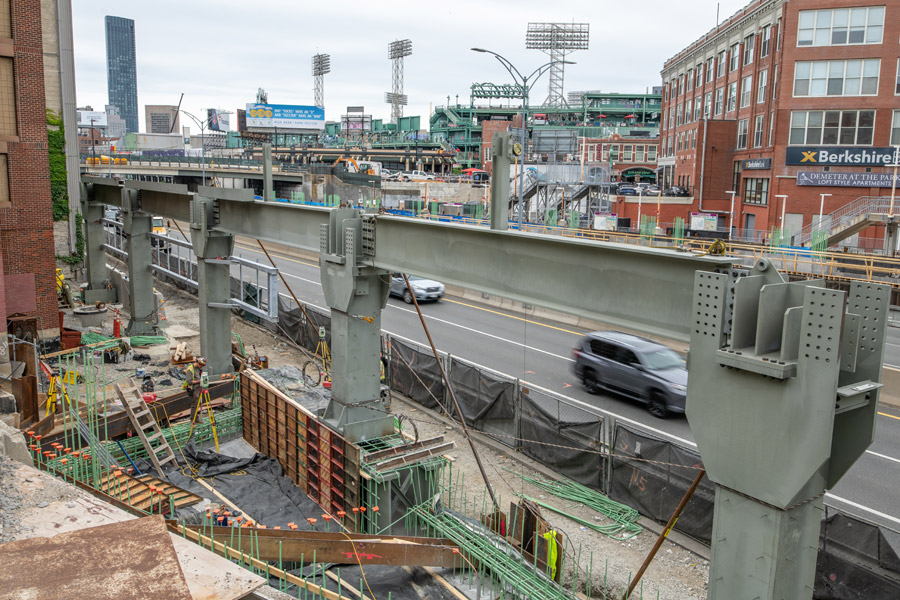
Crews are driving H-Piles and putting the infrastructure in place needed to raise the massive deck on which the $1 billion Fenway Center project will be built.
Photo by Justin Nardella courtesy of IQHQ
*Click on the image for greater detail
Meanwhile, about one-half mile east in the Back Bay area, developer Samuels & Associates recently marked the completion of its own air-rights deck over the highway with a “bridging event.”
The deck, which includes 520 tons of steel, will now serve as the centerpiece for a $700-million project known as Parcel 12 that will include two high-rises—an office tower and a hotel, with a central plaza and retail space in between.
“Any time you get an opportunity to work on a project that is this complex and has this many stakeholders, it is really a once-in-a-career type of opportunity,” said Jeff Gouveia, executive vice president and Northeast division general manager of Suffolk Construction, contractor on the Samuels project. “It is a one-of-a-kind project in a really dynamic environment.”
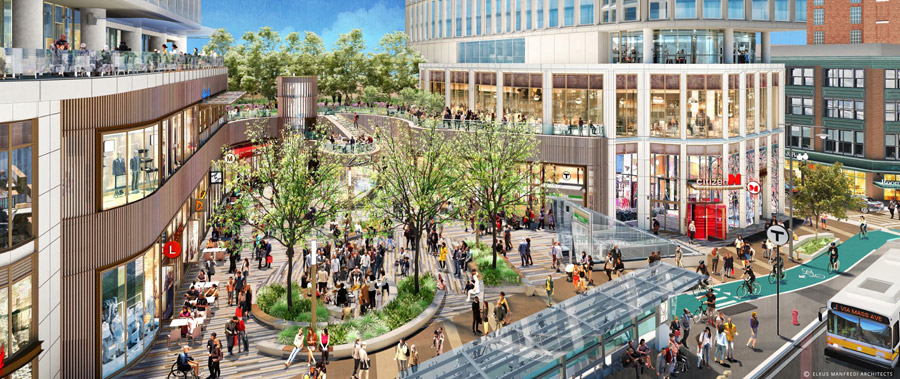
The Parcel 12 project features two high-rises. An office building that will be the new home for Cambridge-based CarGurus is taking shape on one side of the deck, while a Citizen M hotel is rising on the other side.
Rendering courtesy Samuels & Associates
*Click on the image for greater detail
Challenging Projects
While aimed at different parts of the real estate market, both Boston air-rights projects share similar challenges in building over one of the busiest stretches of highway in New England.
Samuels’ newly built air-rights deck crosses eight turnpike lanes, plus a commuter rail, while also abutting MBTA tracks.
Building the deck required a number of temporary lane closures to install pylons and other foundation components, providing a short window of time to deliver materials and complete work, said Jonathan Elliott, vice president of construction at Samuels.
Rolling roadblocks on the Turnpike provided construction crews with a 15-minute window to place each beam into position and bolt it into place. 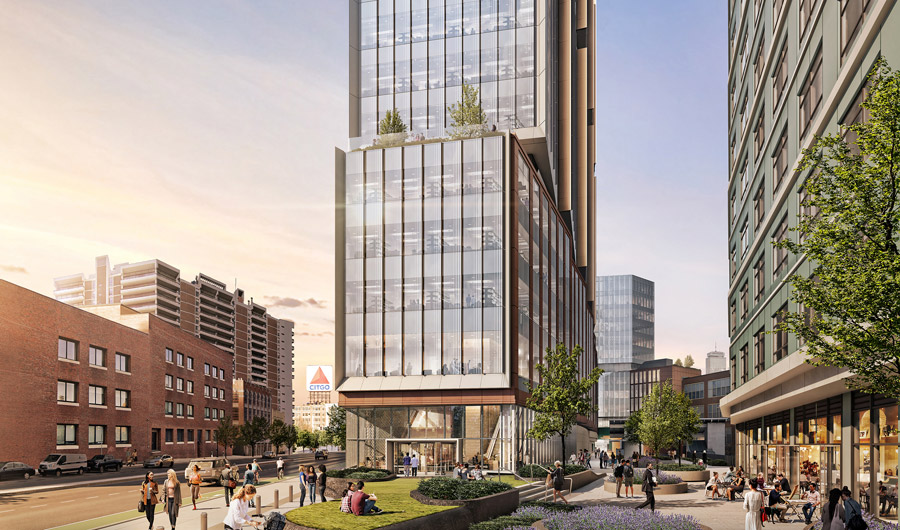
The Fenway Center’s deck over the Massachusetts Turnpike will support the weight of a two-tower, nearly 1 million sq ft life sciences campus.
Rendering courtesy IQHQ
*Click on the image for greater detail
The beams ranged from 30,000 lb to as much as 65,000 lb, Elliott said.
Despite the weight, the highway deck will not have to bear the full load of the project, just a one-story retail building and plaza on the deck itself.
The Parcel 12 project's two towers include an office building that will be the new home for Cambridge-based CarGurus that is taking shape on one side of the deck, while a Citizen M hotel is rising on the other.
Both high-rises foundations extend to the ground below abutting the highway, as well as on strips of land between the railroad and highway and within the highway median itself, and down to bedrock, according to the construction team.
To prevent vibrations from commuter rail and other trains, polymeric bearings have been installed between the sandwich plates at the columns supporting the project.
Key subcontractors working with Suffolk include Regis Steel and G&C Concrete.
Similar to the Samuels project, Fenway Center has required lane closures, which began in April with shutdown of one turnpike lane in each direction. There are also additional late night lane closures as foundation work continues, which also will continue as the deck itself begins to take shape next year, according to a press release from the developer.
Construction crews from general contractor JF Whitehave installed H-piles and those from Phoenix Foundations drilled mini-piles on either side of the Pike.
Both H-piles and mini-piles will soon be installed between the eastbound and westbound lanes of the highway itself, according to the development team.
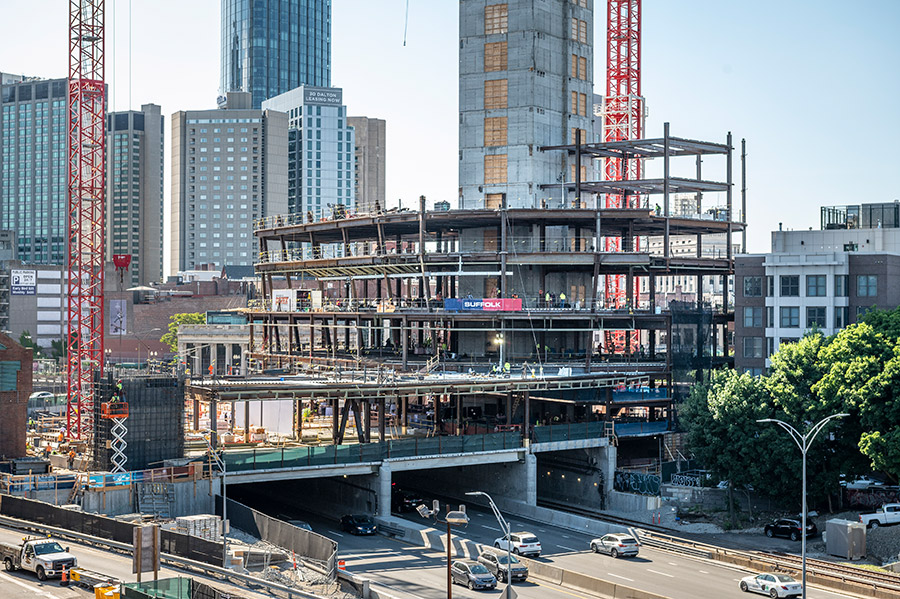
The deck for Parcel 12 includes 520 tons of steel across eight Turnpike lanes, plus the commuter rail, while also abutting MBTA tracks.
Photo courtesy Samuels & Associates
*Click on the image for greater detail
Overall, the deck for Fenway Center, at a sprawling two acres, is a more extensive undertaking than the Parcel 12 deck that Samuels recently completed over the turnpike in the Back Bay.
The deck for the project, which will have to support the weight of a two-tower, nearly 1 million-sq-ft life sciences campus, will be made up of a 7-inch pre-cast slab topped by a 5-inch cast-in-place slab. The lab complex has been designed to vibrate less than 8,000 micro inches per second, or half that experienced by a typical office building, said David Surette, senior vice president at IQHQ.
The reduced vibrations are part of the larger pitch that IQHQ will make to prospective life sciences tenants. The company plans to have key infrastructure in place, including air handling units, generators and “designated space for tenant mechanical equipment, pH neutralization, RODI, or other functionality" required by tenants, Surette says.
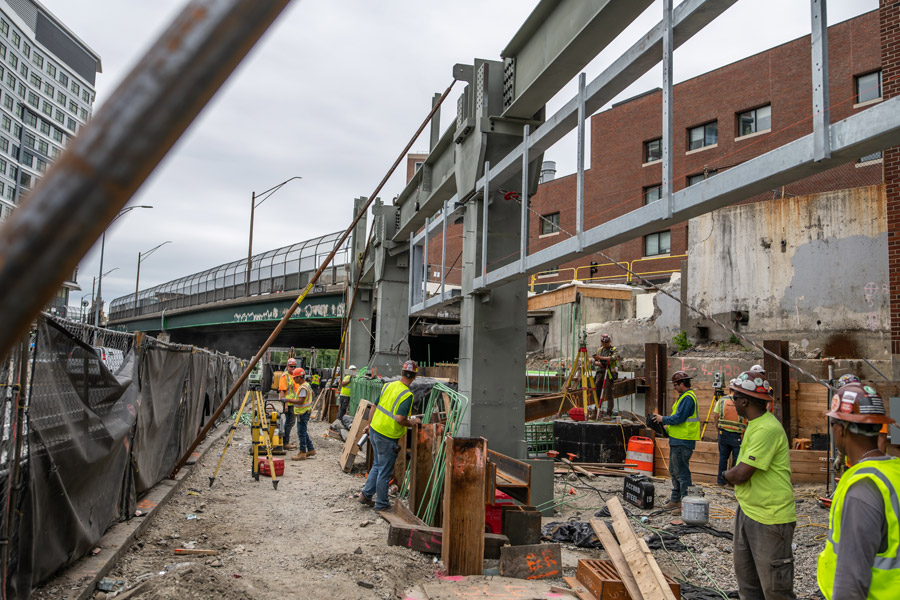
Fenway Center’s deck has required lane closures, which began in April with shutdown of one lane in each direction of the highway. There are also late night lane closures as foundation work progresses, which will continue as the deck begins to take shape next year.
Photo by Justin Nardella courtesy of IQHQ
*Click on the image for greater detail
“Life sciences developers typically do a relatively cold shell,” Surette said. “We try to make our buildings warm shells. It is going to be more ready to go, and they can get their scientists on the benches faster.”
Both projects have been years in the making, having had to undergo intensive state and city reviews while shifting to meet changing market demands.
Rosenthal first proposed the Fenway Center air-rights project two decades ago, aiming to reconnect Fenway Park and Kenmore Square by decking over the turnpike.
But the local developer struggled to nail down financing for the original proposal, which called for an apartment tower on the deck over the highway.
Rosenthal got the project moving by teaming up with California-based IQHQ several years ago, switching the format to life sciences.
The sector is a hot one, with tens of millions of square feet of new lab and research space in the works across the Boston area. Life sciences companies also pay some of the highest rents in the region, with lab space more profitable than either offices or apartments.
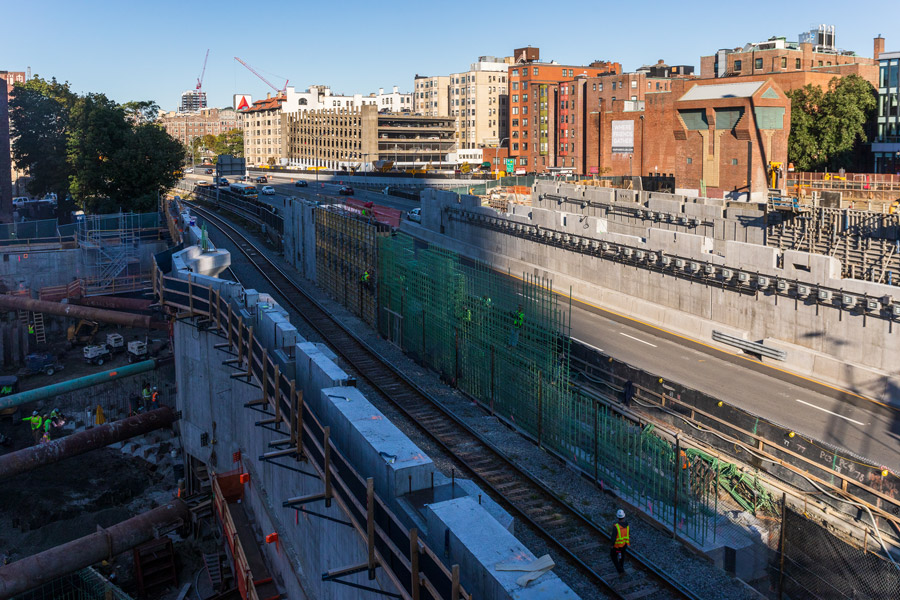
Like Fenway Center, building the deck for Parcel 12 required a number of temporary lane closures to install pilons and do other foundation work.
Photo courtesy Samuels & Associates
*Click on the image for greater detail
That switch–and IQHQ’s commitment to pay the $200 million it will take to build the deck for Fenway Center–led to the start of work last year.
While the life sciences campus won’t open until 2025, it is already attracting interest from potential tenants in the nearby Longwood Medical Area.
“Fenway is a really hot market,” Surette said.
Samuels’ Parcel 12 project has also been in the making for a long time, first proposed a decade ago.
Negotiations with neighborhood, city and state officials led to changes, including the decision to relocate a turnpike on-ramp to improve the safety of drivers, bicyclists and pedestrians along a hectic and dangerous stretch of Massachusetts Avenue.
“We are well into steel erection,” said Abe Menzin, principal and executive vice president of development at Samuels. “Now that the deck is complete, the steel can go to the sky.”




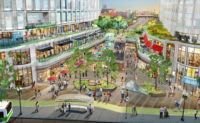

Post a comment to this article
Report Abusive Comment